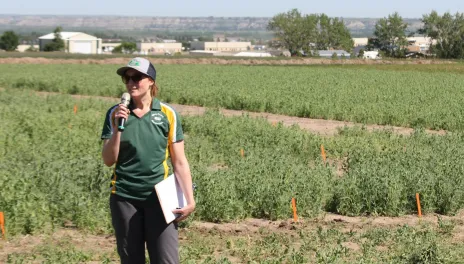WREC Takes a Multi-pronged Approach to Managing Root Rot Diseases
Whether she’s out scouting dry pea, chickpea or lentil fields, conducting soil pathogen tests, managing multiple WREC root rot nurseries, consulting with agronomists and farmers, or working to develop new risk-forecasting tools, root rot is on the mind of Audrey Kalil, Williston Research Extension Center plant pathologist.
According to the U.S. Department of Agriculture, production of pulse crops (dry edible pea, lentil, chickpea and dry bean) in the U.S. has grown exponentially over the past two decades, with more than 3.3 million acres planted to pulse crops in 2020. Most of this growth has taken place in the semiarid regions of the northern Great Plains, Montana and North Dakota, where, along with dry edible pea, lentil has replaced fallow in wheat-fallow production systems.
“The growing production of pulse crops is due in part to the increased demand for plant-based protein in human diets,” explains Kalil. “These high-value crops require minimal nitrogen fertilization and are beneficial in crop rotations, but with the increased adoption of pulse crops in the MonDak region, higher levels of disease from soilborne pathogens causing root rot have occurred over time.”
Kalil and a multi-disciplinary team of NDSU and Montana State University plant pathologists, pulse breeders, and Research Extension Center scientists, are taking a multi-pronged approach to understand and help farmers manage the most devasting of root rot pathogens: Fusarium species and Aphanomyces euteiches.
This approach includes conducting planting date and crop rotation trials, evaluation of fungicide seed treatments, screening breeding lines to identify those with greater tolerance and working with a non-profit lab to generate a soil testing tool to detect these pathogens in soil and plants using their DNA. The team also produces multiple pulse crop disease management guides, consults with growers at field days and regional educational events, and provides information on the Growing Pulse Crops Podcast.
One of the newest projects the team is working on is a root rot risk forecasting tool. The tool could potentially combine field history submitted by a grower, with soil testing for pathogen DNA and other soil characteristics to determine the level of root rot risk in a field.
“Our hope is that by understanding root rot risk a grower can have more confidence planting peas and lentils, and it helps them stay in the pulse production business,” says Kalil. “These crops have been extremely important economically and we need to find ways to maintain this critical industry for the state.”
FOR MORE INFORMATION:
WREC Plant Pathology Research and Outreach
Dry Pea and Lentil Root Rot Management Guide
Pulse Crop Production Field Guide for North Dakota
Audrey Kalil, 701-651-6459, audrey.kalil@ndsu.edu

